BSC 121 Exam #2 (Shakirov)
1/245
There's no tags or description
Looks like no tags are added yet.
Name | Mastery | Learn | Test | Matching | Spaced |
|---|
No study sessions yet.
246 Terms
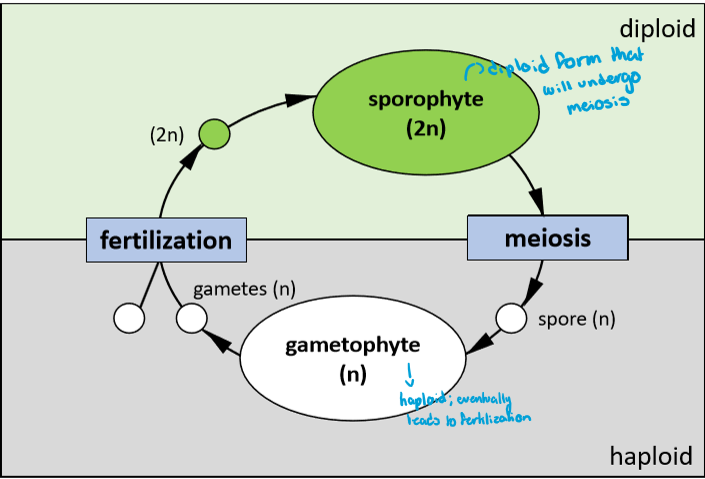
haploid: meiosis; gametophyte (n)
diploid: fertilization; sporophyte (2n)
What is the alternation of generations in a plant’s life cycle
cuticle and sporopollenin (thick spore wall) to remove moisture
stomata to facilitate gas exchange and regulate water loss
symbiotic relationship with fungi to obtain nutrients from soil
distinctive features of land plants and their adaptations developed to live in drier environments
cuticle
waxy surface coating that helps reduce water loss from plant surfaces
embryophytes
land plants that appeared 450 mya; sporophyte has a resting stage when it forms
apical meristems
differentiated tissues that arise from one or more actively dividing cells at the growing tips
sporophyte
a diploid zygote divides by mitosis to produce a ________
spores
tough-walled, non-flagellate cells; produced when a mature sporophyte undergoes meiosis
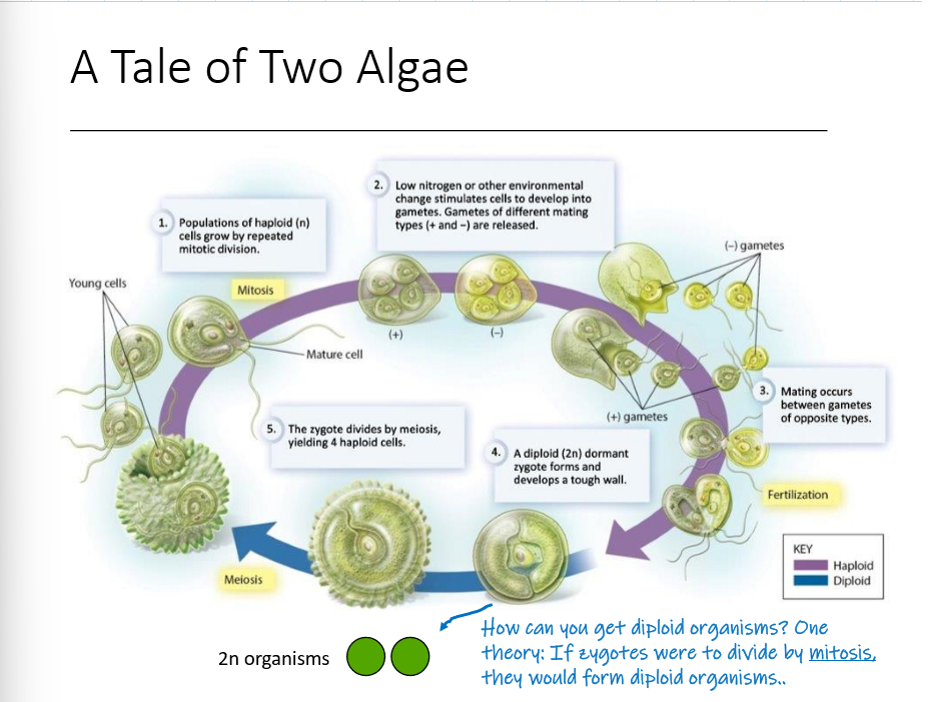
populations of haploid cells grow by repeated mitotic division
Cells are stimulated into developing into gametes (both + and - are released)
mating occurs between gametes of opposite types
a diploid dormant zygote forms and develops a tough wall
the zygote divides by meiosis, yielding 4 haploid cells
Explain the life cycle of a zygote.
bryophytes
have a waxy cuticle and pores or stomata but lack tracheids; do not have vascular tissue; liverworts, mosses, and hornworts
tracheids
specialized cells for water transport
alternation of generations in mosses
Antheridia has numerous spermatogenous cells that develop into sperm cells. Biflagellate so they need water to swim to the egg (located inside the archegonium).
nutrients between the sporophyte and gametophyte move along the cell walls using a placenta
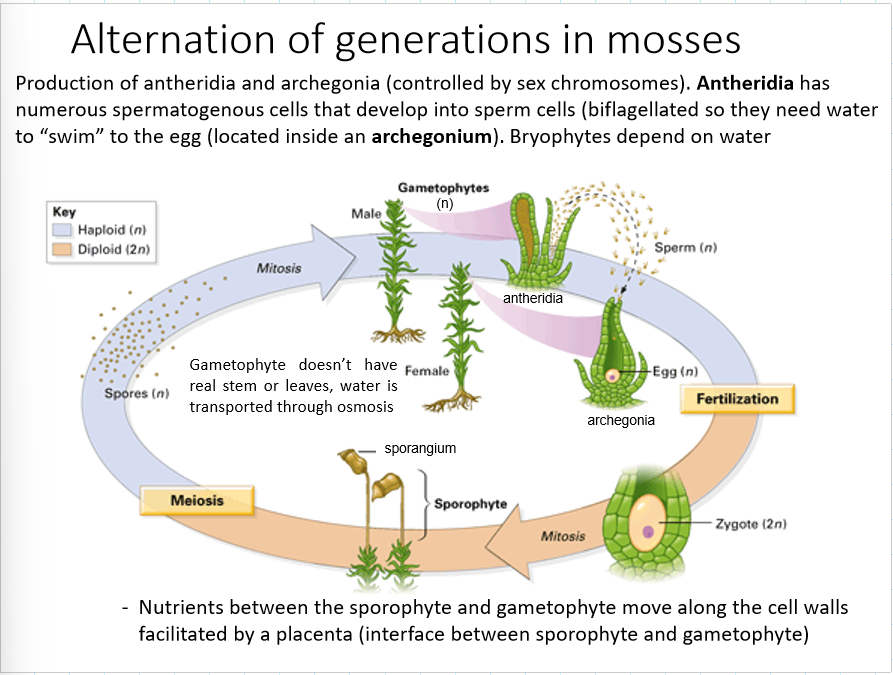
attached to the gametophyte
nutritionally dependent on the gametophyte
bears a single sporangium
lacks conducting tissues
Explain the characteristics of sporophytes in mosses.
prominent generation (for most)
free living
undifferentiated
Rhizoids
Explain the characteristics of gametophytes in mosses.
there is a lack of vascular bundles, so there is no branching and only one sporangia per sporophyte
Why is the growth of moss limited?
tracheophytes
evolved 420 mya; produce internal water and nutrient conducting tissues that also provide structural supports
branched and contain conducting tissues- phloem for sugars and xylem with lignin to conduct water and provide structural support
Explain the structure of stems of vascular plants and what they do.
specialized in water and mineral uptake from the soil
Explain the function of roots of vascular plants
flattened, specialized in photosynthesis
Explain the structure and function of leaves in vascular plants.
they are the base for most ecosystems, they sustain and feed us, and we harvest many of their compounds as medicine
how are vascular plants useful?
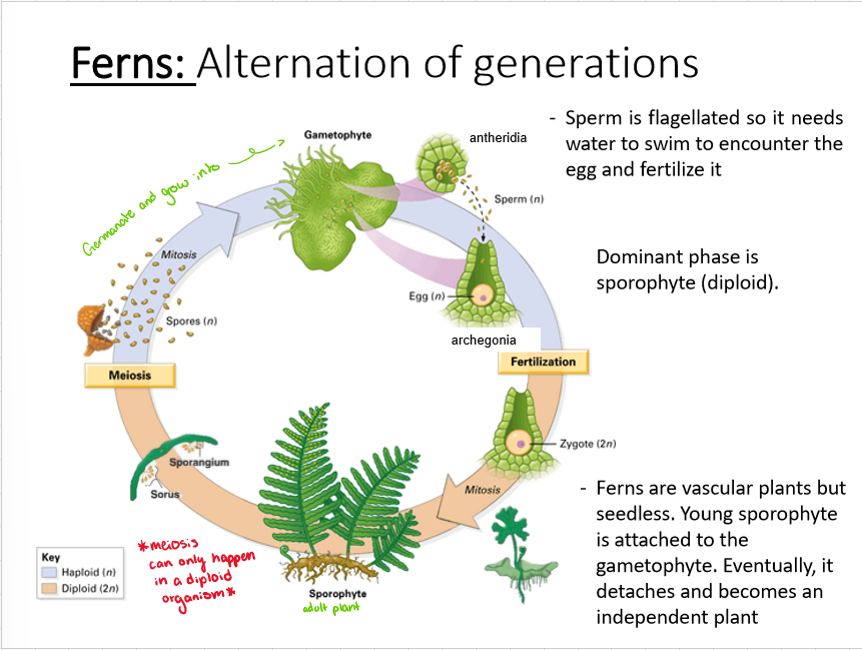
sperm is flagellated so it needs water to swim to encounter the egg and fertilize it
dominant phase is sporophyte (diploid)
vascular plants but seedless; young sporophyte is attached to the gametophyte, but eventually detaches and becomes an independent plant
Explain the alteration of generations for ferns!
dominant generation
becomes independent
roots, stems, and leaves
many sporangia
What are four characteristics of vascular plant sporophytes?
free-living
short-lived
What are two characteristics of vascular gametophytes?
spermatophytes
seed producing plants; includes gymnosperms and angiosperms
cycads, ginkgos, conifers, and gnetophytes
differentiated spores- mega and microspores
depend on the sporophyte
female gametophyte is food for sporophyte embryo
male and female cones
What are five characteristics of gymnosperms?
mega- retained in the sporangium
micro- develop as pollen grains
Explain megaspores vs microspores.
flowering plants
female gametophyte (n) enclosed in ovary (2n)
male and female gametophytes (n) are part of the flower (2n)
What are three characteristics of angiosperms?
they utilize double fertilization
one sperm + ovule = zygote or embryo
2nd sperm + central cell (2 nuclei) = endosperm
Explain the alteration of generations in angiosperms:
provide protection and nutrition to the embryonic sporophyte
increase survival value
great advantage over plants that shed their spores
What are three characteristics of seeds?
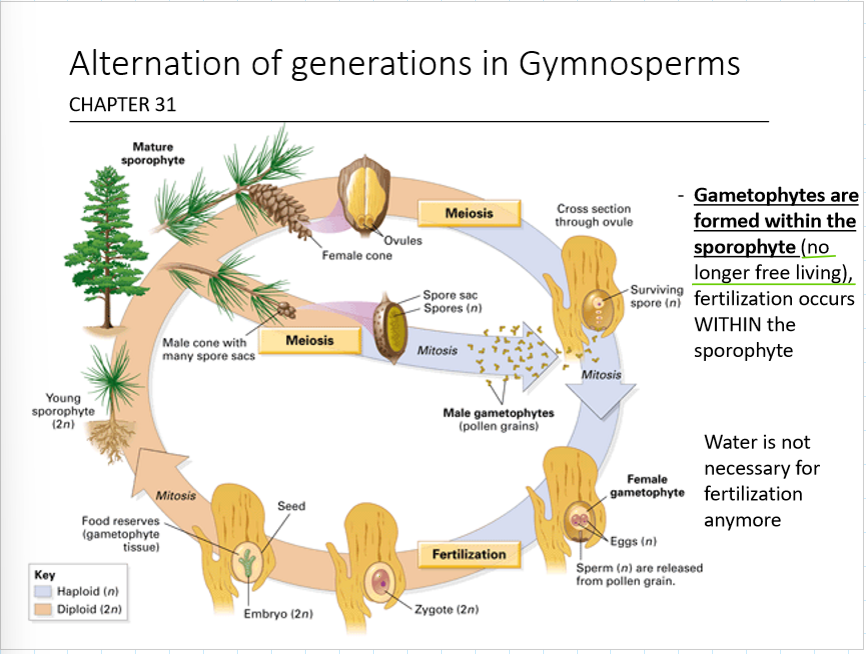
gametophytes are formed within the sporophyte (no longer free-living)
fertilization occurs within the sporophyte
water is not necessary for fertilization anymore
Explain the alteration of generations in gymnosperms:
higher dominance of the sporophyte
gametophytes are microscopic and nutritionally dependent on the sporophyte (which is much bigger)
What happened to the sporophyte over time in gymnosperms and angiosperms?
microspores and megaspores
What are the two types of spores produced by seed plants?
microspores (pollen)
produced by microsporangia; contain the male gametes
megaspores (ovule)
produced by megasporangia; enclosed in sporophytic tissue called integument; each one contains only one egg
seeds contain female gametophyte tissue rich in carbohydrates, proteins, and lipids
single fertilization (sperm + egg = embryo)
What are two characteristics of a gymnosperm ovule:
double fertilization (sperm 1 + egg = embryo, sperm 2 + 2 polar nuclei = endosperm)
female gametophyte only has 7 cells
What are two characteristics of an angiosperm ovule:
seed coats protect seeds and are adapted for dispersion in many ways
seeds store a lot of food which helps the embryo develop and germinate
fertilization is not dependent on water; pollen tubes deliver the sperm directly into the ovule
What are the three advantages of producing seeds?
development of soils increased fertility
rise of oxygen levels in the atmosphere reduced CO2 levels and increase O2 levels
evolution of modern plant communities
colonization of land by animals because of greater O2 levels
rise of seed plants contributed to diversification of insects
How have land plants changed the earth? (5 ways)
seedless vascular plants
gymnosperms and angiosperms evolved from _____ _______ _______
wood, paper, food industry, cosmetics, and medicines
What are gymnosperms and angiosperms used for? (5 things)
vascular cambium
makes wood and inner bark with secondary growth
pollen
allows for the dispersal of male gametophyte
ovules
protect and nourish female gametophytes and developing embryos
seeds
facilitates dispersal
secondary xylem, produced by a second meristem called cambium
pipe-like arrays of empty, water conducting cells with lignin walls
What are two characteristics of wood?
lignin walls
provides physical and structural support
bark
produced by a cork cambium to prevent the epidermis splitting when the vascular tissues expand
primary growth
pith, phloem, xylem, and sclerenchyma
secondary growth
pith, primary and secondary phloem, cork, bark, cortex, epidermis, vascular and cork cambium, and primary and secondary xylem
true! up to a year can pass from pollination to fertilization, and seed maturation might take 3 years
true/false: gymnosperms are slow to reproduce
false! they grow throughout most of the world, and they are the dominant vegetation in many colder and arctic regions
true/false: gymnosperms grow in very few areas of the world
earliest diverging lineage of gymnosperms
palm like; not usually very tall
many produce coralloid roots
plants produce either female or male cone-like structures
insects are the main agents of pollination
seeds are dispersed by birds, bats, etc.
What are 6 characteristics of cycads?
cycads
seed plants that typically have a stout and woody (ligneous) trunk with a crown of large, hard, stiff, evergreen and (usually) pinnate leaves
conifers life cycle (picture)
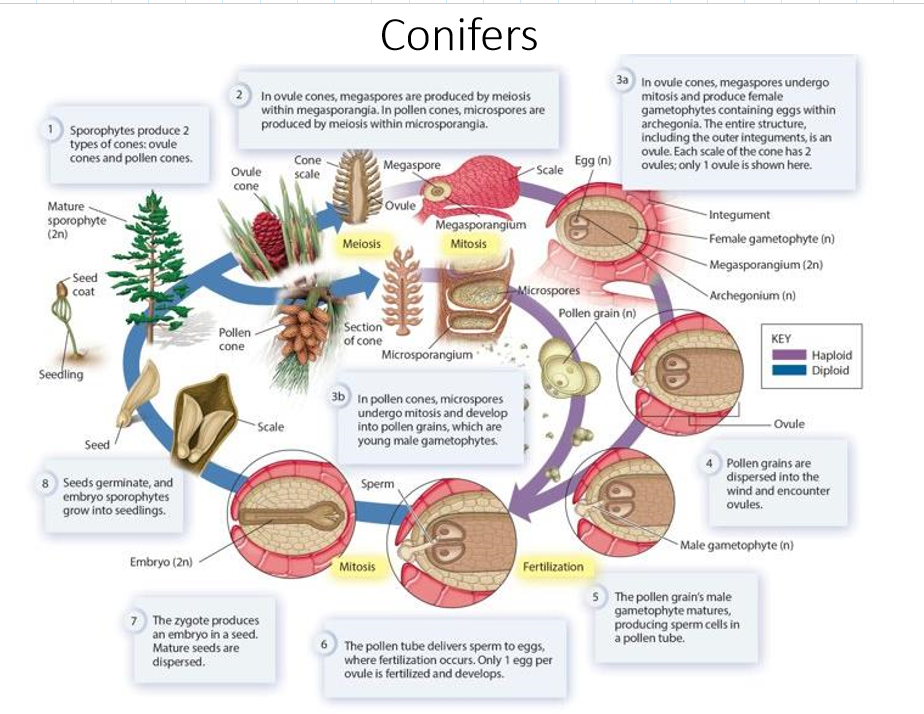
seeds (NOT fruits) can be dispersed by wind or by animals
their wood contains specialized tracheids that makes water movement efficient and valves that prevent air bubbles
have resin to prevent attacks from pathogens and herbivors
What are three characteristics of conifers?
conical shape helps them shed snow
leaf shape and structure resists damage from drought
scale-like or needle-like leaves reduce area to decrease evaporation
thick, waxy cuticle in leaves reduces water loss and attack of insects
How have conifers adapted to colder weather?
gnetum, ephedra, and welwitschia mirabilis
What are the three types of gnetales?
gnetum
broad leaves; 30 spp. of vines, shrubs, or trees in tropical africa or asia
ephedra
scale-like leaves, whorled, photosynthetic branches; 35 spp. around the world
welwitschia mirabilis
strange looking plant, long taproot, stubby stem barely visible, only 2 leaves that grow continuously and shred; 1 sp. restricted to the Namib Desert in SE Africa
flowers: foster seed production
fruits: favor seed dispersal
endosperm: provides food for the embryo to develop
vessels: water conducting cells (wider than tracheids)
What are four key innovation of angiosperms?
flowers
produced at stem tips, contain sepals, petals, pollen-producing stamens, and ovule-producing carpels; # of organs varies greatly
when it lacks one of the four key organs
what makes a flower an incomplete flower?
facilitate pollination
everything in the flower is designed to:
organs of a flower (picture)
stamen (anther + filament), pistil (stigma + style + ovary), perianth (petal + sepal), ovules, receptacle, and pedicel
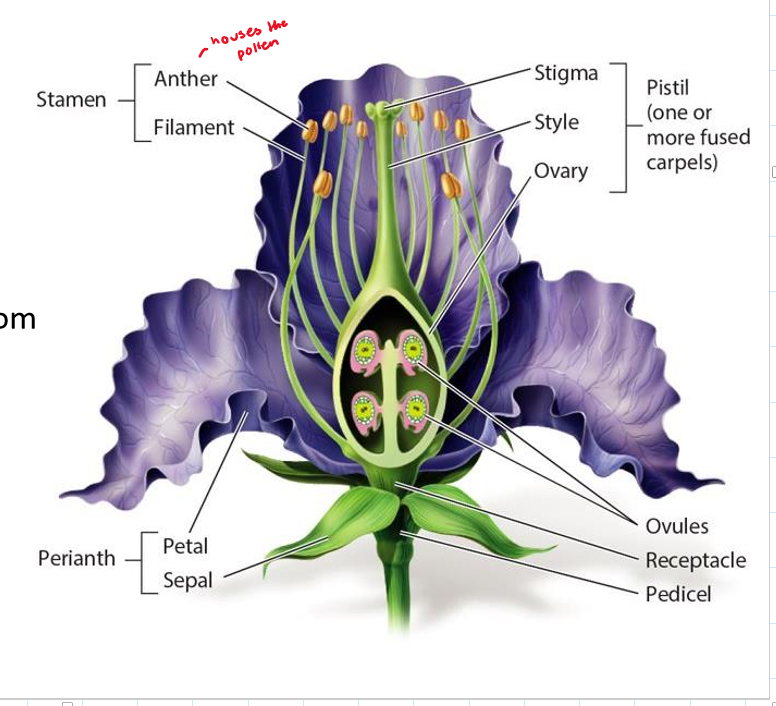
life cycle of angiosperms (picture)
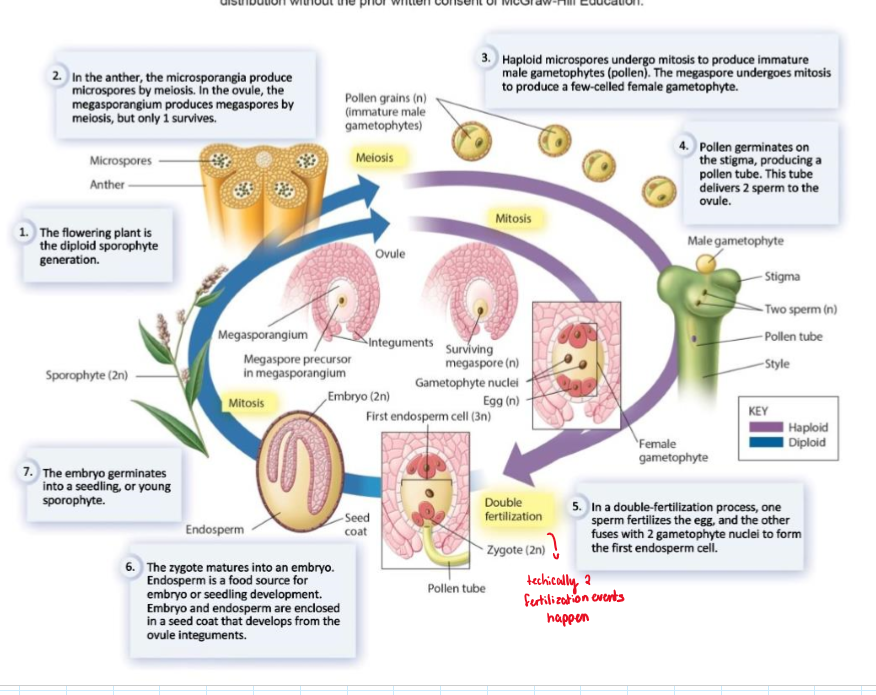
secondary metabolites
organic compounds not essential for cell structure or growth, but aid in survival and reproduction
terpenes and terpenoids, phenolic compounds, and alkaloids
What are 3 types of secondary metabolites?
coevolution
when two or more species of organisms influence each other’s evolutionary pathway
one pollinator at risk
specialists
many pollinators at risk
generalists
multicellular
no cell walls (more flexibility)
heterotrophs (animals ingest and digest)
mobility (w/ muscle and nerve cells forming tissues)
mostly sexual reproduction
What are 5 characteristics of animals?
an increase in atmospheric and aquatic oxygen levels
formation of the ozone layer
evolution of hox genes (body differentiation)
an evolutionary “arms race” between prey and predator
What are the 4 probable causes for a sudden increase in animal diversity?
lungs
internal fertilization
amniotic egg with shell
What are three key adaptations that allowed animals to colonize terrestrial environments (prevented them from drying out and enabled them to breath, move, and reproduce on land)
protist; monophyletic
all animals descend from a _____ ancestor, and as a group, animals are _________
type of body symmetry
number of germ layers
specific features of embryonic development
what are the three main morphological and developmental features animals have been traditionally classified using
no symmetry (earliest diverging animals like sponges)
radially symmetry; often circular or tubular in shape (cnidarians like jellyfish)
bilateral: two halves that are mirror images
What are the three types of body symmetry?
endoderm, ectoderm, and mesoderm (specific to bilateria)
*sponges have no germ layers
What are the three germ layers?
endoderm
a type of germ layer; the inner layer, lines the primitive digestive tract
ectoderm
a type of germ layer; outer layer, covers the surface of the embryo and differentiates into the epidermis and nervous system
mesoderm
a type of germ layer; forms muscles and most other organs between the digestive tract and the ectoderm
tripoblastic
having a body derived from three embryonic cell layers (ectoderm, mesoderm, and endoderm), as in all multicellular animals except sponges and coelenterates.
diploblastic
having a body derived from only two embryonic cell layers (ectoderm and endoderm) but no mesoderm), as in sponges and coelenterates.
specific features of embryonic development in Bilateria
protostomes and deuterostomes
protostomes
blastopore becomes the mouth (ex. spiralians)
deuterostomes
blastopore becomes the anus (radial cleavage)
determinate cleavage
if a cell is separated in a 4-cell embryo, the development stops
indeterminate cleavage
if a cell is separated in a 4-cell embryo, that one cell as well as the other 3 cells can develop into an embryo (results in identical twins in humans)
coelom
fluid-filled body cavity; cushion for internal organs and allows them to move and grow independently of the outer body wall. In soft-bodied invertebrates, it works as a hydrostatic skeleton, giving support and shape to their bodies
coelomate
cavity completely covered in mesoderm
psueodocoelomate
cavity NOT completely covered in mesoderm
acoelomate
lack a coelom. instead of fluid, they contain mesenchyme tissue
segmentation
the body is divided into regions
evident in some groups (annelids, arthropods), but les so in chordates (fish, mammals, etc.)
allows specialization of body regions
ctenophores
comb jellies; have two long sticky tentacles that trap prey and eats it; digestion occurs in the gastrovascular cavity; the earliest animals
hemaphrodites
an animal having both male and female sex organs or other sexual characteristics, either abnormally or (in the case of some organisms) as the natural condition.
1. have two long sticky tentacles
2. hermaphrodites
3. lacks true HOX genes
4. has 8 rows of cillia that looks like combs
5. THE LARGEST ANIMAL TO USE CILIA FOR LOCOMOTION
What are five features of ctenophores?
ctenophores
earliest divergent lineage of animals
porifera
the phylum of sponges
rotational symmetry
A type of symmetry a figure has if it can be rotated less than 360 degrees about its center and still look like the original.
sponges (porifera)
Most ancestral animals, no body symmetry, no germ cell layers (lack true tissue)
spongocel
large central cavity of the sponge